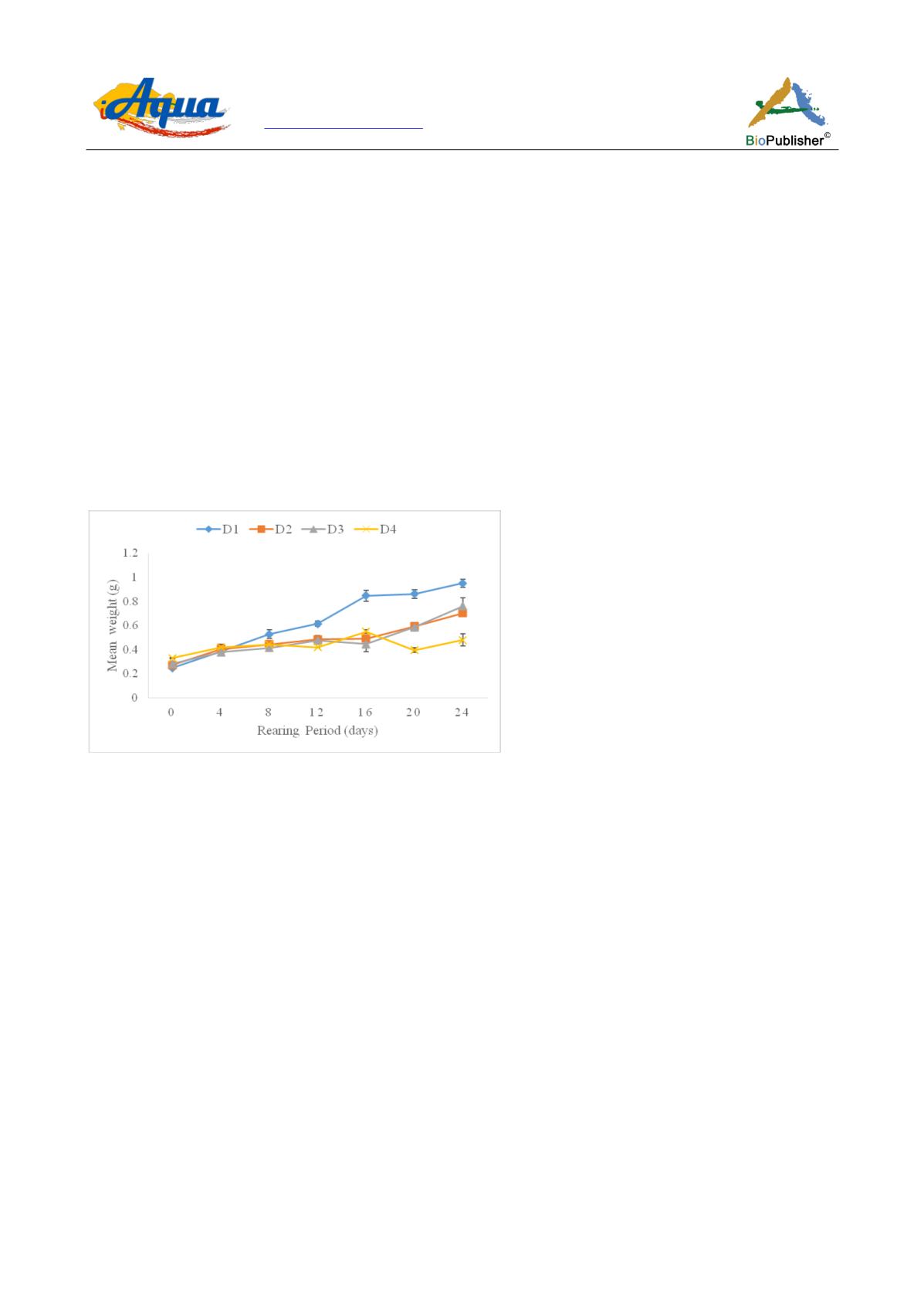
International Journal of Aquaculture, 2018, Vol.8, No.18, 137-144
141
In experimental conditions, the current study shows that
H. occipitalis
tadpoles develop as well as metamorphosis
when they are reared at density of five (05) individuals per liter of water. This density is nearby the normal
recommended for
R. catesbeiana
tadpoles in commercial farms (Lopes-Lima and Agostinho, 1992; Flores-Nava,
1997). Besides, the highest final mean weight (0.735±0.026 g) in this experiment was recorded in D
1
(05 tadpoles/L)(Figure 3).
These results are closed to those obtained (0.449-1.383 g) by Martìnez et al. (1996) during their study on growth
and metamorphosis of
Rana perezi
Seoane (1885) tadpoles. These results are also similar to those obtained
(0.403-0.716 g) by Murray (1990) in
Rana sylvatica
tadpoles. Although, these latter are lower than the results of
Browne et al. (2003) and Munguia-Fragozo et al. (2015) during their studies on the effect of high density on
growth, development and survival of
Litoria aurea
tadpoles and the effect of density on growth and metabolism of
R. catesbeiana
tadpoles. This may due not only to the difference of species but the difference of rearing
techniques. Indeed, it was demonstrated that space availability can influence tadpoles’ development (Flores-Nava
and Vera-Muñoz, 1999). According to Wilbur and Collins (1973), tadpoles reared at low stocking densities are
able to pass minimal body height to initiate metamorphosis process and maximize their height after. Nevertheless,
it can be difficult to compare precisely these studies because Browne et al. (2003) studied
L. aurea
in Australia
and Munguia-Fragozo et al. (2015) focused on
R. catesbeiana
in Mexico. Factors to be considered are for instance
temperature variations, differences in experimental designs and water quality management.
Figure 3 Biomass progression of
Hoplobatrachus occipitalis
tadpoles reared in ponds at four (04) stocking densities for 24 days
Specific growth rate recorded during the current experiment ranged between 1.960 ±0.326 and 4.220 ±0.255%/d
(Figure 1). These results are closed to those of many authors (Martìnez et al., 1996; Flores-Nava and Vera-Muñoz,
1999)
Rana perezi
and
Rana catesbeiana
tadpoles. Besides, many studies indicate specific growth rate of tadpoles
are negatively tied to the intensity of inter specific competition observed in high density media (Wilbur and
Collins, 1973; Crump, 1981; Semlitsch and Caldwell, 1982; Berven and Chadra, 1988; Tejedo and Reques, 1992).
Our results show specific growth rate of
H. occipitalis
tadpoles is inversely proportional to density. The best
results were obtained in ponds with low stocking density (5 tadpoles/L). That confirms results of Browne et al.
(2003) who showed high stocking densities of tadpoles provokes stress conditions which affect their survival and
growth (height and metamorphosis time). According to Semlitsch and Caldwell (1982), specific growth rate
decreases while density increases. Besides, water renewal allows a good growth of tadpoles. For example, prior
studies revealed that in
R. catesbiana
water renewal drops temperature thus favor good growth performance
(Flores-Nava et al., 1994).
During the experiment, food conversion rate of
H. occipitalis
tadpoles varied from 1.436 ±0.023 and 2.185 ±
0.218. The best rate was recorded in density of 5 tadpoles/L. These results are different from those obtained by
Flores-Nava and Vera-Muñoz (1999)
Rana catesbeiana
tadpoles (0.5 tadpoles/L). This could be justified by social
interactions existing between feed and space. Indeed, in several reared species, growth is inversely proportional to
density, what is principally attributed to social interactions (Siddiqui et al., 1989, Irwin et al., 1999). We also
supposed in our study that equal feed particles were consumed by each tadpole at each feeding time. Moreover,
they were some competitive interactions in ponds limiting tadpoles’ equal access to feed. It’s important to notice


